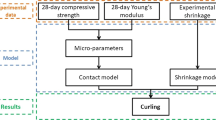Abstract
Moisture curling occurs due to non-uniform moisture distribution in a concrete slab. The curled geometry and self-weight of the slab induce undesirable high stress region near the drying surface, and may cause cracks when external wheel loadings are applied. Therefore, alleviating the degree of curling is an important issue in pavement design, and a proper prediction scheme is essential in design process. In this paper, a systematic procedure for predicting moisture curling of slab is presented including material model description, material model calibration, and finite element simulation. The study employs a material model describing elastic response, creep, drying shrinkage, and thermal expansions. The material model is incorporated into a finite element analysis (FEA) code ICON developed at University of Illinois. The material model and prediction scheme were validated with the experimental result of a single slab moisture curling test conducted at the National Airport Pavement Test Facility (NAPTF).
























Similar content being viewed by others
References
Bradbury RD (1938) Reinforced concrete pavements. Wire Reinforcement Institute, Washington, DC, 190 pp
Weserggard HM (1926) Analysis of stresses in concrete pavement due to variation of temperature. In: Proceedings. Highway Research Board, Washington, DC
Mindess S, Young JF (1981) Concrete. Prentice-Hall, Englewood Cliffs, NJ
Cook RD et al (2002) Concepts and application of finite element analysis, 4th edn. Wiley, New York
ABAQUS INC (2005) ABAQUS/Standard user’s manual. Pawtucket
Chowdhury SR, Narasimhan R (2000) A cohesive finite element formulation for modeling fracture and delamination in solids. Sadhana Acad Proc Eng Sci 25(6):561–587
Zhang Z, Paulino GH (2005) Cohesive zone modeling of dynamic failure in homogeneous and functionally graded materials. Int J Plast 21:1195–1254
Bazant ZP (1977) Viscoelasticity of solidifying porous material-concrete. J Eng Mech 103:1049–1067
Bazant ZP, Prasannan S (1989) Solidification theory for concrete creep I: formulation. J Eng Mech 115(8):1691–1703
Bazant ZP, Prasannan S (1989) Solidification theory for concrete creep II: verification and application. J Eng Mech 115(8):1704–1725
Atrushi DS (2003) Tensile and compressive creep of early age Concrete, in Civil Engineering. The Norwegian University of Science and Technology, Trondheim, p 314
Bentz DP, Garboczi EJ, Quenard DA (1998) Modelling drying shrinkage in reconstructed porous materials: application to porous Vycor glass. Model Simul Mater Sci Eng 6:211–236
Grasley ZC (2006) Measuring and modeling the time-dependent response of cementitious material to internal stresses, in Civil and Environmental Engineering. University of Illinois, Urbana-Champaign, p 218
Bazant ZP, Baweja S (1995) Creep and shrinkage prediction model for analysis and design of concrete structures—model B3. Mater Struct 28:357–365
Roesler J et al (2007) Concrete fracture prediction using bilinear softening. Cem Concr Compos 29:300–312
Song SH, Paulino GH, Buttlar WG (2006) A bilinear cohesive zone model tailored for fracture of asphalt concrete considering viscoelastic bulk material. Eng Fract Mech 73:2829–2848
Lee CJ (2007) Response of concrete structures subject to material aging and volume instability, in Civil and Environmental Engineering. University of Illinois, Urbana-Champaign, p 194
ASTM (2002) Standard test method for static modulus of elasticity and Poisson’s ratio of concrete in compression. American Society for Testing and Materials, Philadelphia
ASTM (2005) Standard test method for compressive strength of cylindrical concrete specimens. American Society for Testing and Materials, Philadelphia
ASTM (2002) Standard test method for creep of concrete in compression. American Society for Testing and Materials, Philadelphia
Wesche K (1991) Fly ash in concrete: properties and performance. RILEM, London
Sensirion (2002) Preliminary specifications for SHT1x/SHT7x humidity and Temperature. Sensmitter, Zurich
Acknowledgements
The authors wish to acknowledge the support for this work from the Federal Aviation Administration through the Center of Excellence for Airport Technology at University of Illinois.
Author information
Authors and Affiliations
Corresponding author
Rights and permissions
About this article
Cite this article
Lee, C.J., Lange, D.A. & Liu, YS. Prediction of moisture curling of concrete slab. Mater Struct 44, 787–803 (2011). https://doi.org/10.1617/s11527-010-9665-x
Received:
Accepted:
Published:
Issue Date:
DOI: https://doi.org/10.1617/s11527-010-9665-x




